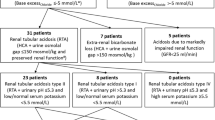Abstract
Background
Gap acidosis, a type of metabolic acidosis caused by titratable acid accumulation, participates in CKD progression. It was found at all the stages of chronic kidney disease (CKD), whereas the kidney was believed to preserve its ability to excrete titratable acid until renal function is impaired severely.
Methods
Serum concentrations of lactate (Lac) and the other usually unmeasured anions (OUA) were separately examined using 420 records of blood gas analysis performed simultaneously with serum chemistry at a general hospital.
Results
Between the records grouped by the CKD stage, Lac was generally higher in the early stages than the late stages (2.2 ± 1.1, 1.9 ± 1.7, 1.5 ± 1.3, and 1.2 ± 0.6 mmol/L in G1–2, G3, G4, and G5, respectively). While OUA was not significantly different between G1–2, G3, and G4 (1.3 ± 2.0, 2.5 ± 2.7, and 2.6 ± 2.2 mEq/L, respectively), it was higher in G5 (4.7 ± 2.3 mEq/L) than in G1–4 (P < 0.001). In G5, OUA generally increased as eGFR decreased, and OUA was 6.6 ± 1.9, 4.7 ± 2.1 and 3.6 ± 2.0 mEq/L in subgroups of eGFR < 5, 5–10, and 10–15 mL/min/1.73 m2, respectively (P ≤ 0.001).
Conclusions
Gap acidosis except lactic acidosis developed and progressed during the CKD stage G5, while lactic acidosis developed in the CKD stages G1–4. Prevention of lactic acidosis by preserving peripheral perfusion in the early CKD stages could slow CKD progression.


Similar content being viewed by others
References
Hamm LL, Nakhoul N, Hering-Smith KS. Acid–base homeostasis. Clin J Am Soc Nephrol. 2015;10:2232–42.
Kraut JA, Madias NE. Metabolic acidosis of CKD: an update. Am J Kidney Dis. 2016;67:307–17.
Nagami GT, Hamm LL. Regulation of acid–base balance in chronic kidney disease. Adv Chronic Kidney Dis. 2017;24:274–9.
Abramowitz MK, Hostetter TH, Melamed ML. Lower serum bicarbonate and a higher anion gap are associated with lower cardiorespiratory fitness in young adults. Kidney Int. 2012;81:1033–42.
Eustace JA, Astor B, Muntner PM, Ikizler TA, Coresh J. Prevalence of acidosis and inflammation and their association with low serum albumin in chronic kidney disease. Kidney Int. 2004;65:1031–40.
Phisitkul S, Khanna A, Simoni J, Broglio K, Sheather S, Rajab MH, Wesson DE. Amelioration of metabolic acidosis in patients with low GFR reduced kidney endothelin production and kidney injury, and better preserved GFR. Kidney Int. 2010;77:617–23.
de Brito-Ashurst I, Varagunam M, Raftery MJ, Yaqoob MM. Bicarbonate supplementation slows progression of CKD and improves nutritional status. J Am Soc Nephrol. 2009;20:2075–84.
Berend K, de Vries AP, Gans RO. Physiological approach to assessment of acid–base disturbances. N Engl J Med. 2014;371:1434–45.
Phisitkul S, Hacker C, Simoni J, Tran RM, Wesson DE. Dietary protein causes a decline in the glomerular filtration rate of the remnant kidney mediated by metabolic acidosis and endothelin receptors. Kidney Int. 2008;73:192–9.
Hakim RM, Lazarus JM. Biochemical parameters in chronic renal failure. Am J Kidney Dis. 1988;11:238–47.
Abramowitz MK, Hostetter TH, Melamed ML. The serum anion gap is altered in early kidney disease and associates with mortality. Kidney Int. 2012;82:701–9.
Kraut JA, Madias NE. Lactic acidosis. N Engl J Med. 2014;371:2309–19.
Kraut JA, Xing SX. Approach to the evaluation of a patient with an increased serum osmolal gap and high-anion-gap metabolic acidosis. Am J Kidney Dis. 2011;58:480–4.
Morris CG, Low J. Metabolic acidosis in the critically ill: part 2. Causes and treatment. Anaesthesia. 2008;63:396–411.
Figge J, Jabor A, Kazda A, Fencl V. Anion gap and hypoalbuminemia. Crit Care Med. 1998;26:1807–10.
Carvounis CP, Feinfeld DA. A simple estimate of the effect of the serum albumin level on the anion gap. Am J Nephrol. 2000;20:369–72.
Feldman M, Soni N Dickson B. Influence of hypoalbuminemia or hyperalbuminemia on the serum anion gap. J Lab Clin Med. 2005;46:317−20.
Matsuo S, Imai E, Horio M, Yasuda Y, Tomita K, Nitta K, Yamagata K, Tomino Y, Yokoyama H, Hishida A; Collaborators developing the Japanese equation for estimated GFR. Revised equations for estimated GFR from serum creatinine in Japan. Am J Kidney Dis. 2009;53:982−92.
Widmer B, Gerhardt RE, Harrington JT, Cohen JJ. Serum electrolyte and acid base–composition. The influence of graded degrees of chronic renal failure. Arch Intern Med. 1979;139:1099–102.
Wallia R, Greenberg A, Piraino B, et al. Serum electrolyte patterns in endstage renal disease. Am J Kidney Dis. 1986;8:98–104.
Hsu CY, Chertow GM. Elevations of serum phosphorus and potassium in mild to moderate chronic renal insufficiency. Nephrol Dial Transplant. 2002;17:1419–25.
Remer T. Influence of nutrition on acid–base balance–metabolic aspects. Eur J Nutr. 2001;40:214–20.
Toyohara T, Akiyama Y, Suzuki T, Takeuchi Y, Mishima E, Tanemoto M, Momose A, Toki N, Sato H, Nakayama M, Hozawa A, Tsuji I, Ito S, Soga T, Abe T. Metabolomic profiling of uremic solutes in CKD patients. Hypertens Res. 2010;33:944–52.
Spiegel DM. Magnesium in chronic kidney disease: unanswered questions. Blood Purif. 2011;31:172–6.
Author information
Authors and Affiliations
Corresponding author
Ethics declarations
Conflict of interest
The author has no conflicts of interest to declare.
Ethical standards
The study was conducted in accordance with the guidelines written in the Declaration of Helsinki. The study was approved by the ethics committee of Shin-Kuki General Hospital (Approved number 0002) and written informed consent from individual patients was waived.
Additional information
Publisher’s Note
Springer Nature remains neutral with regard to jurisdictional claims in published maps and institutional affiliations.
About this article
Cite this article
Tanemoto, M. Gap acidosis except lactic acidosis develops and progresses during chronic kidney disease stage G5. Clin Exp Nephrol 23, 1045–1049 (2019). https://doi.org/10.1007/s10157-019-01743-4
Received:
Accepted:
Published:
Issue Date:
DOI: https://doi.org/10.1007/s10157-019-01743-4




